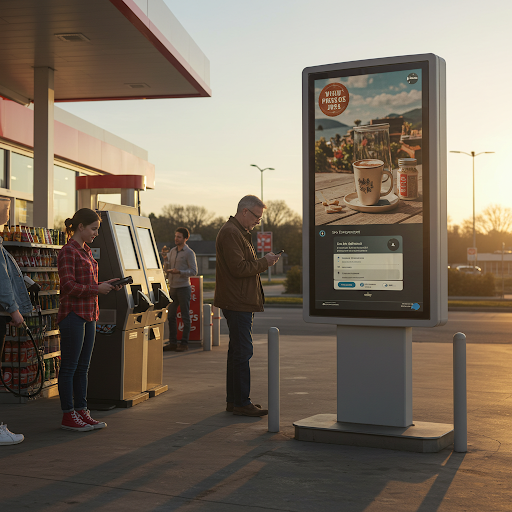Estimated reading time: 5 minutes
This article series is dedicated to a deep and comprehensive exploration of the role of artificial intelligence in business. We will examine how companies of various sizes and across different industries are leveraging machine learning, generative AI, and neural networks to drive growth, improve efficiency, and gain a competitive edge.
Each article will focus on a specific area of application — whether it’s AI in retail, logistics, or human resource management. We will pay special attention to practical case studies as well as the ethical, legal, and strategic aspects of AI implementation.
This is not just a review of trendy technologies — it’s a conversation about the transformation of business logic in an era where algorithms can make decisions as well as humans.
Artificial Intelligence, or AI. It’s everywhere, isn’t it? You hear about it constantly, promising to revolutionize everything. But for us folks running convenience stores and gas stations, the big question is: what does it actually do for us? Is it just fancy tech talk, or can it really help us run our stores better, save money, and keep customers happy? It’s easy to get caught up in the buzz, but we need to cut through the noise and see what’s real versus what’s just hype.
Let’s be honest, “AI” can mean a lot of things. Sometimes it’s complex machine learning figuring out patterns, other times it’s smart automation that just feels like magic. For our industry, it often boils down to using data in smarter ways to make better decisions or automate tasks that eat up our time.
Real Applications Delivering Value Today
So, where is AI actually making a difference right now in C-stores and fuel retail? Based on what we’re seeing and what we’ve experimented with ourselves at Market24, here are a few key areas:
- Automated Inventory Tracking & Ordering: This is a big one. Manually counting stock, tracking expiration dates, and figuring out reorders takes hours. AI-powered back-office systems, like Petrosoft’s Retail360 (which we use), but also others like PDI Enterprise or Modisoft, can automate a lot of this. They analyze sales data, predict demand, and even suggest orders. We found at Market24 that implementing AI-driven inventory alerts significantly cut down on both stockouts of popular items and waste from over-ordering slower movers. It wasn’t perfect overnight, mind you, we had to wrestle with the learning curve, but the data it provides now is invaluable.
- Predictive Pricing and Shrink Reduction: Fuel pricing is notoriously tricky. AI tools can analyze competitor pricing, demand patterns, and historical data to suggest optimal fuel prices throughout the day. On the shrink side, AI is getting smarter too. Tools like Petrosoft’s Loss Prevention Analytics (LPA), or insights you might get from PDI’s Lottery Insights, use data (sometimes even camera feeds) to spot unusual patterns that might indicate theft – whether it’s at the pump, the register, or with lottery tickets. It helps focus your attention where it’s needed most.
- Customer Insights via Loyalty Apps: Understanding your customers is key. Modern loyalty apps, like those from Petrosoft Loyalty, Punchh, or Upside, often use AI behind the scenes. They analyze purchasing habits to figure out what offers will actually bring a specific customer back in. Instead of generic coupons, you can send targeted promotions for things they actually buy. We’ve tried a couple different loyalty approaches at Market24, and the ones that used smarter segmentation definitely showed better results than the old ‘one-size-fits-all’ approach.
What Doesn’t Work (Yet) or Needs Caution
What about overpromised AI Checkout Experiences. Remember all the hype around Amazon’s Just Walk Out stores? Grab your stuff and leave? While the tech is cool, they actually pulled it from their big Fresh grocery stores. It turns out scaling that complex system of cameras and sensors is really hard and expensive, especially for the average C-store layout. While AWS still offers the tech to places like stadiums and airports, and they’re working on simpler versions, don’t expect fully automated checkout to be standard in most C-stores tomorrow. It’s just not practical or cost-effective for most operators right now.
We have all had pa+oorly Integrated Systems. AI is only as good as the data it gets. If your “AI” fuel pump system doesn’t talk properly to your back-office inventory system, or your POS doesn’t integrate smoothly with your loyalty app, you’re not getting the full benefit. You end up with data silos and headaches. Integration is key, and sometimes the AI features sound better on paper than they work in reality if the connections aren’t solid.
SmartPOS vs. Legacy Systems: What about the POS itself? Does a new “SmartPOS” have more AI than trusty systems like Gilbarco Passport or Verifone Commander/RubyCi? It’s complicated. Gilbarco and Verifone are masters of integration intelligence – reliably connecting pumps, payment networks, and core C-store functions. Their AI might be more subtle, focused on operational reliability. Newer systems like Petrosoft’s SmartPOS might leverage AI more explicitly for things like analytics directly tied to their back-office data or loss prevention modules. Systems like Clover or Toast offer lots of apps but might lack the deep, built-in fuel and C-store specific intelligence unless you add specific integrations. It’s less about “who has AI” and more about what kind of intelligence you need for your specific operation.
AI isn’t magic, but it’s definitely more than just hype when applied correctly. Focus on tools that solve real problems you face every day – inventory, shrink, pricing, customer loyalty. Be skeptical of grand promises that sound too good (or too expensive) to be true, and always ask about integration. In the next part, we’ll look at what the wider retail world can teach us about using AI effectively, and what pitfalls to avoid.

Michael is a one of the industry experts that contribute to Petrosoft blog. Read more of his c-store and gas station insights click here


